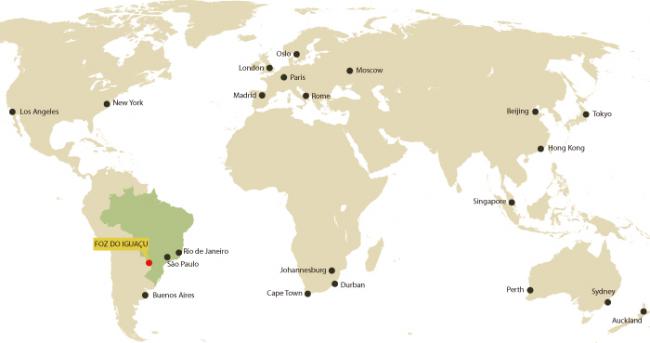About Brazil
Brazil – a country that greets visitors with a huge smile
The mixture of races has made Brazil a culturally rich and at the same time unique country. This miscegenation began with the Indians, the Africans and the Portuguese, but in a short time, immigrants from around the world began to arrive: Europeans, Asians, and people of the Middle East. The result was a happy people, open to everything new, a people only found in Brazil.
Because of this tremendous diversity, Brazil is one of the places on earth where no one is a foreigner, where one can change one’s destiny without losing one’s identity and where each and every Brazilian has a little of the entire world in his or her blood. This may be the reason why the Brazilian receives anyone from another land so well. According to surveys carried out with foreign tourists who visited the country, 97.2% intended to return soon; 56.5% had their expectations completely satisfied; and, for 31.7%, their expectations were completely exceeded. As you can see, those who come to Brazil become fans on the first visit.
Brazil is the largest country in Latin America. It spreads across almost half (47.3%) of South America, and occupies a total area of 8,547,403.5 km2. It is the fifth largest country in the world after Canada, the Russian Federation, China and the United States. Except for a small number of islands, Brazil is a single and continuous land mass. The Equator passes through the northern region, near Macapá, and the Tropic of Capricorn cuts through the south of the country, near São Paulo.
Brazil’s east to west extension (4,319.4 km) is almost equivalent to its north to south distance (4,394.7 km). The country borders French Guiana, Suriname, Guiana, Venezuela and Colombia, to the north; Uruguay and Argentina, to the south; and Paraguay, Bolivia and Peru, to the west. Ecuador and Chile are the only two countries in the South American continent that do not border Brazil. The Atlantic Ocean extends along the country’s entire eastern coast, providing 7,367 km of coastline.
Language
The official language is Portuguese; however, the accent and the intonation are very different from what one hears in Portugal and other former Portuguese colonies. Some people say that Brazilians speak “Brazilian”, just like Americans can say they speak “American”, and not English. And there are also many Brazilians who are descendants of immigrants and who speak German and Italian, especially in cities in southern Brazil.
 |
 |
Brazil´s vast territory, allied with factors such as temperature, altitude, barometric pressure and proximity to the ocean, provides the country with climatic conditions to please everyone. It is one of the richest and most complex ecosystems in the world, with extremely diversified vegetation and sceneries.
Brazil is divided into climatic zones: 92% of the country is located between the Equator and the Tropic of Capricorn. We can, therefore, say that the Brazilian climate is predominantly tropical, with equatorial and subtropical zones distributed over the remaining 8% of the nation’s territory. The predominance of lower altitudes throughout the country provides more elevated temperatures, with averages exceeding 20°C.
The seasons are the exact opposite of those in Europe and the United States, except in the Northern region of the country. The average annual temperature is approximately 28ºC in the Northern region and 20ºC, in the South. Extreme temperatures are rare, but they may occur: in winter, some cities in the south of the country experience negative temperatures, with frost and snow. And in Rio de Janeiro, in the peak of summer, the temperature may reach the 40ºC mark.

